Victorian architecture
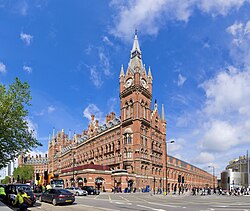
Victorian architectureis a series ofarchitectural revival stylesin the mid-to-late 19th century.Victorianrefers to the reign ofQueen Victoria(1837–1901), called theVictorian era,during which period the styles known as Victorian were used in construction. However, many elements of what is typically termed "Victorian" architecture did not become popular until later in Victoria's reign, roughly from 1850 and later. The styles often included interpretations andeclecticrevivalsof historic styles(seeHistoricism).The name represents the British and French custom of naming architectural styles for a reigning monarch. Within this naming and classification scheme, it followedGeorgian architectureand laterRegency architectureand was succeeded byEdwardian architecture.
Although Victoria did not reign over the United States, the term is often used for American styles and buildings from the same period, as well as those from theBritish Empire.
Victorian architecture in the United Kingdom
[edit]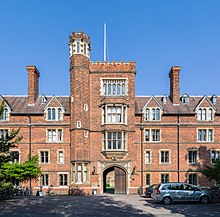
Gothic Revival
[edit]During the early 19th century, the romanticmedievalGothic Revivalstyle was developed as a reaction to thesymmetryofPalladianism,and such buildings asFonthill Abbeywere built.[1]
By the middle of the 19th century, as a result of newtechnology,construction was able to incorporate metal materials as building components. Structures were erected withcast ironandwrought ironframes. However, due to being weak in tension, these materials were effectively phased out in place for more structurally soundsteel.[2]One of the greatest exponents ofiron frameconstruction wasJoseph Paxton,architect ofthe Crystal Palace.Paxton also continued to build such houses asMentmore Towers,in the still popularEnglish Renaissancestyles. New methods of construction were developed in this era of prosperity, but ironically the architectural styles, as developed by such architects asAugustus Pugin,were typically retrospective.
InScotland,the architectAlexander Thomsonwho practised inGlasgowwas a pioneer of the use ofcast ironandsteelfor commercial buildings, blending neo-classical conventionality with Egyptian and Oriental themes to produce many truly original structures. Other notable Scottish architects of this period areArchibald SimpsonandAlexander Marshall Mackenzie,whose stylistically varied work can be seen in thearchitecture of Aberdeen.
While Scottish architects pioneered this style it soon spread right across the United Kingdom and remained popular for another forty years. Its architectural value in preserving and reinventing the past is significant. Its influences were diverse but the Scottish architects who practiced it were inspired by unique ways to blend architecture, purpose, and everyday life in a meaningful way.
Other Revival styles
[edit]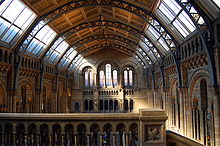
- Jacobethan(1830–1870; the precursor to theBritish Queen Anne Revivalstyle)
- Renaissance Revival(1840–1890)
- Neo-Grec(1845–1865)
- Romanesque Revival
- Second Empire(1855–1880; originated inFrance)
- British Queen Anne Revival(1870–1910)
- Scots Baronial(predominantly Scotland)
- BritishArts and Crafts movement(1880–1910)
Some styles, while not uniquely Victorian, are strongly associated with the 19th century owing to the large number of examples that were erected during that period:
-
Royal Albert Hall,London
-
The "Red Brick"Victoria Buildingat theUniversity of Liverpool,completed in 1893 inGothic Revivalstyle. Designed byAlfred Waterhouse
-
The Victorian Pavilion atThe Ovalcricket ground in London
-
Victorian School of Art and Science atStroud,Gloucestershire
-
TheJohn Rylands Libraryin Manchester
-
TheAston Webbbuilding at theUniversity of Birmingham,UK
-
Victoria Law Courts,Birmingham, UK
-
The Gilbert Scott Building of theUniversity of Glasgow,as viewed fromKelvingrove Park,Glasgow.An example of theGothic Revivalstyle
-
North of Scotland Bank in Aberdeen byArchibald Simpson1839–42
-
Balmoral Castle,completely rebuilt for Queen Victoria, an example of theScots Baronial style
-
WalsallVictorian Arcade, UK
-
Barclays Bank building,Sutton,Greater London
-
Forth Rail Bridge,Firth of Forth, near Edinburgh, Scotland, UK
International spread of Victorian styles
[edit]
During the 18th century, a few English architects emigrated to the colonies, but as theBritish Empirebecame firmly established during the 19th century, many architects emigrated at the start of their careers. Some chose the United States, and others went to Canada, Australia, New Zealand, and South Africa. Normally, they applied architectural styles that were fashionable when they left England. By the latter half of the century, however, improving transport and communications meant that even remote parts of the Empire had access to publications such as the magazineThe Builder,which helped colonial architects keep informed about current fashion. Thus, the influence of English architecture spread across the world. Several prominent architects produced English-derived designs around the world, includingWilliam Butterfield(St Peter's Cathedral, Adelaide) andJacob Wrey Mould(Chief Architect of Public Works inNew York City).
Australia
[edit]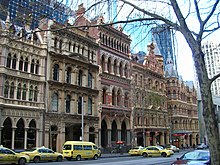
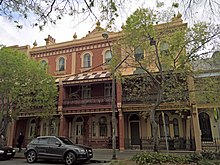
The Victorian period flourished in Australia and is generally recognised as being from 1840 to 1890, which saw agold rushand population boom during the 1880s in the states ofNew South WalesandVictoria.There were fifteen styles that predominated:[3]
- Victorian Georgian
- Victorian Regency
- Egyptian
- Academic Classical
- Free Classical
- Filigree
- Mannerist
- Second Empire
- Italianate
- Romanesque
- Tudor
- Academic Gothic
- Free Gothic
- Rustic Gothic
- Carpenter Gothic
The Arts and Crafts style and Queen Anne style are considered to be part of theFederationPeriod, from 1890 to 1915.[4]
-
Melbourne's world heritageRoyal Exhibition Building,built in 1880 (Free Classical)
-
General Post Office, Sydney,in the Free Classical style (1891)
-
St Peter's Cathedral, Adelaide(Gothic Revival)
-
Sydney Town Hall,in Second Empire style
-
Queen Victoria Buildingin Romanesque style (1898)
-
South Melbourne Town Hallin Second Empire style
-
St Mary's Cathedral, Sydney,in Victorian Gothic architecture (1882)
-
Victorian Mannerist architecture lining a street in Sydney
-
State Library of Victoriaof the Academic Classical style (1870)
-
Brookman Hall,UniSA City East Campus, Adelaide, South Australia
-
Italianate home inRandwick
-
Filigreestyle terraces inSurry Hillswith ornate iron-wrought detailing
-
Second Empire andFiligreeresidence inSouth Yarra
Hong Kong
[edit]Western influence in architecture was strong whenHong Kongwas aBritish colony.Victorian architecture in Hong Kong:
-
Former Marine Police Headquarters(now officially named as '1881 Heritage', which is a hotel and a shopping mall)
Ireland
[edit]
Georgian architectureis more prominent in Ireland than Victorian architecture. The cities of Dublin, Limerick, and Cork are famously dominated byGeorgian squaresandterraces.Though Victorian architecture flourished in certain quarters. Particularly around Dublin'sWicklow Streetand UpperBaggot Streetand in the suburbs ofPhibsboro,Glasnevin,Rathmines,Ranelagh,Rathgar,Rathfarnham,andTerenure.The colourfulItalianatebuildings ofCobhare excellent examples of the regional Victorian style in Ireland. Further examples of Victorian architecture in the country include Dublin'sGeorge's Street Arcade,theRoyal City of Dublin Hospitalon Baggot Street and theRoyal Victoria Eye and Ear Hospitalon Adelaide Road.
-
A Victorian terrace inCobhknown as the "deck of cards"
-
Victorian shops and cafes, including theGeorge's Street Arcade,DublinD02
-
Victorian UpperBaggot Street,DublinD02
-
Victorian terraced houses in DublinD6W
-
Rathmines Clock Tower, Rathmines, DublinD06
-
The Royal City of Dublin Hospital, DublinD04
-
National Botanic Gardens glasshouse, Glasnevin, Dublin D09
-
The Royal Victoria Eye and Ear Hospital, Adelaide Road, DublinD02
Sri Lanka
[edit]During the British colonial period of British Ceylon: Sri Lanka Law College, Sri Lanka College of Technology, Galle Face Hoteland the Royal CollegeMain Building.
North America
[edit]
In the United States, 'Victorian' architecture generally describes styles that were most popular between 1860 and 1900. A list of these styles most commonly includesSecond Empire(1855–85),Stick-Eastlake(1860–c. 1890),Folk Victorian(1870–1910),Queen Anne(1880–1910),Richardsonian Romanesque(1880–1900), andShingle(1880–1900). As in the United Kingdom, examples of Gothic Revival and Italianate continued to be constructed during this period and are therefore sometimes called Victorian. Some historians classify the later years of Gothic Revival as a distinctive Victorian style named High Victorian Gothic.Stick-Eastlake,a manner of geometric, machine-cut decorating derived from Stick and Queen Anne, is sometimes considered a distinct style. On the other hand, terms such as "Painted Ladies"or"gingerbread"may be used to describe certain Victorian buildings, but do not constitute a specific style. The names of architectural styles (as well as their adaptations) varied between countries. Many homes combined the elements of several different styles and are not easily distinguishable as one particular style or another.
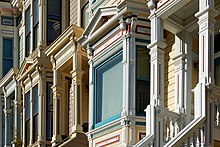
Notable Victorian-inspired cities during this era include,AstoriainOregon;PhiladelphiaandPittsburghinPennsylvania;Washington, D.C.;BostoninMassachusetts;Alameda,Eureka,San Francisco,andMidtownSacramentoinCalifornia;TheBrooklyn HeightsandVictorian Flatbushsections ofNew York City,Garden CityonLong Island,andAlbany,Troy,Buffalo,andRochesterinUpstateNew York;Asbury Park/Ocean Grove,Cape May,Deal,Flemington,Freehold,Hackettstown,Jersey City/Hoboken,Metuchen,Montclair,Ridgewood,Plainfield,Summit,andWestfieldinNew Jersey;Chicago,Galena,andWinnetkainIllinois;DetroitandGrand RapidsinMichigan;CincinnatiandColumbusinOhio;GalvestoninTexas;BaltimoreinMaryland;LouisvilleinKentucky;AtlantainGeorgia;MilwaukeeinWisconsin;New OrleansinLouisiana;RichmondinVirginia;St. LouisinMissouri;andSaint PaulinMinnesota.Los Angelesgrew from aPueblo(village) into aVictorian Downtown– now almost entirely demolished but with residential remnants in itsAngelino HeightsandWestlakeneighborhoods. San Francisco is particularly well known for its extensive Victorian architecture, especially in theHaight-Ashbury,Lower Haight,Alamo Square,Western Addition,Mission,Duboce Triangle,Noe Valley,Castro,Nob Hill,andPacific Heightsneighborhoods.

The extent to which any one is the "largest surviving example" is debated, with numerous qualifications. TheDistillery Districtin Toronto, Ontario contains the largest and best-preserved collection of Victorian-era industrial architecture in North America.[citation needed]Cabbagetownis the largest and most continuous Victorian residential area in North America.[citation needed]Other Toronto Victorian neighbourhoods includeThe Annex,Parkdale,andRosedale.In the US, theSouth Endof Boston is recognized by theNational Register of Historic Placesas the oldest and largest Victorian neighborhood in the country.[5][6]Old LouisvilleinLouisville, Kentucky,also claims to be the nation's largest Victorian neighborhood.[7][8]Richmond, Virginiais home to several large Victorian neighborhoods, the most prominent beingThe Fan.The Fan district is best known locally as Richmond's largest and most 'European' of Richmond's neighborhoods and nationally as the largest contiguous Victorian neighborhood in the United States.[9]TheOld West Endneighborhood ofToledo, Ohiois recognized as the largest collection of late Victorian andEdwardianhomes in the United States, east of theMississippi.[10]Summit AvenueinSaint Paul, Minnesota,has the longest line of Victorian homes in the country.Over-The-RhineinCincinnati, Ohio,has the largest collection of early VictorianItalianate architecturein the United States,[11][12][13]and is an example of an intact 19th-century urban neighborhood.[14]According to National Register of Historic Places,Cape May Historic Districthas one of the largest collections of late 19th century frame buildings left in the United States.[15]
The photo albumL'Architecture AmericainebyAlbert Levypublished in 1886 is perhaps the first recognition in Europe of the new forces emerging in North American architecture.[16]
-
Pennsylvania Academy of Fine Arts,Philadelphia, byFrank Furness
-
Allegheny County Courthouse,Pittsburgh, Pennsylvania, byHenry Hobson Richardson
-
TheCalifornia Southern Railroad's San Diego passenger terminal, built in 1887
-
Brooklyn Bridge,1883, New York City
-
TheCarson MansioninEureka, California,widely considered one of the highest executions ofQueen Anne style,built 1884–86
-
John Steinbeck's childhood home inSalinas, California
-
1880s photo of 653 W Wrightwood (now 655 W Wrightwood) in theLincoln Parkneighborhood ofChicago,Illinois
-
James J. Hill HouseinSt. Paul, Minnesota,built in 1891
-
TheJacob C. Allen House(c. 1870) inHackettstown, New Jersey
Canada
[edit]Canada'schief dominion architectsdesigned numerous federal buildings over the course of the Victorian era.Thomas Fuller'scompletion of theCanadian Parliament Buildingsin 1866, in particular, established a High Victorian Gothic influence over Canadian architectural design for several consecutive decades, producing many public buildings, churches, residences, industrial buildings, and hotels.[20]



-
British Columbia Parliament Buildings(main block)
-
Office of the Prime Minister and Privy Council(formerly Langevin Block)
-
Old Galt Post Office Building
-
Parliament Buildings (Centre Block and Library)
-
Thomas Fuller Building (Brockville, Ontario)
-
University College, TorontoMain Building
-
Winnipeg City Hall (1887)
India
[edit]Because India was a colony of Britain, Victorian Architecture is prevalent in India, Especially in cities likeMumbai,Kolkata, Kerala and Chennai, In Mumbai (Formerly called Bombay) buildings likeMunicipal Corporation Building,Bombay University,Bombay High Court,Asiatic Society of Mumbai Building (Former Town Hall)and theDavid Sasoon Libraryare some example of Victorian Architecture in Mumbai. In Kolkata (Formerly called Calcutta) buildings like theVictoria Memorial,Calcutta High Court,St Paul's Cathedral,The Asiatic Society of Bengalare some examples of Victorian Architecture in Kolkata. In Chennai (Formerly called Madras) some examples includeMadras High court,State Bank of MadrasandSt. Mary's Church.[21]Many churches and colleges such asSanta Cruz Cathedral Basilica Kochi,University College Trivandrum,Government College of Fine Arts Trivandrum,Napier Museum,State Central Library of Kerala,Government Victoria College Palakkad,CMS College KottayamandSB College Changanasserryare some of finest examples of Victorian architecture in Kerala.
Preservation
[edit]Efforts to preserve landmarks of Victorian architecture are ongoing and are often led by theVictorian Society.A recent campaign the group has taken on is the preservation of Victoriangasometersafter utility companies announced plans to demolish nearly 200 of the now-outdated structures.[22]
See also
[edit]- Victorian decorative arts
- Victorian house
- Victorian restoration
- Folk Victorian
- Albert Levy (photographer)
- Georgian architecture
References and sources
[edit]Citations
[edit]- ^"Fonthill Abbey | house, Wiltshire, England, United Kingdom | Britannica".www.britannica.com.Retrieved2022-06-02.
- ^Blank, Alan; McEvoy, Michael; Plank, Roger (1993). Architecture and Construction in Steel. Taylor & Francis.ISBN0-419-17660-8
- ^Apperly, Irving & Reynolds 1994,pp. 40–97.
- ^Apperly, Irving & Reynolds 1994,pp. 132–143.
- ^"South End Realty Community".Archived fromthe originalon 16 July 2011.
- ^"South End Historical Society".
- ^"Louisville Facts & Firsts".LouisvilleKy.gov.Archivedfrom the original on 6 October 2014.Retrieved14 December2009.
- ^"What is Old Louisville?".Old Louisville Guide. Archived fromthe originalon 27 November 2009.Retrieved14 December2009.
- ^"The Fan District – Great Public Spaces- Project for Public Spaces (PPS)".Archived fromthe originalon 1 December 2008.
- ^Stine, L. (2005) Historic Old West End Toledo, Ohio. Bookmasters.
- ^Quinlivan (2001)
- ^"Cincinnati.com".Cincinnati.com.Archivedfrom the original on 20 January 2015.Retrieved1 May2018.
- ^Lonely Planet (14 January 2016)."Top 10 US travel destinations for 2012".Lonely Planet.Archivedfrom the original on 6 September 2015.
- ^Over-the-Rhine Chamber of Commerce,Over-the-Rhine Historical SitesArchived11 September 2009 at theWayback Machine
- ^"Cape May Historic District".National Park Service.Retrieved27 February2021.
- ^Lewis 1975.
- ^"Saitta House - Report Part 1Archived2008-12-16 at theWayback Machine",DykerHeightsCivicAssociation.com
- ^"Gingerbread Trim: Feast your eyes on these ornate Victorian-era embellishments".This Old House. 2 February 2007.Retrieved12 January2020.
- ^"Eldridge Johnson House, 33 Perry Street (moved from 225 Congress Street), Cape May, Cape May County, NJ".Historic American Buildings Survey (Library of Congress).Retrieved12 January2020.
- ^Christopher Thomas (2015)"Canadian Architecture: 1867-1914".The Canadian Encyclopedia.Retrieved 11 April 2022
- ^"British India and Victorian-Era Architecture".victorianweb.org.Retrieved2022-07-15.
- ^Sean O'Hagan,Gasworks wonders…Archived23 September 2016 at theWayback Machine,The Guardian,14 June 2015.
Sources
[edit]- Apperly, Richard; Irving, Robert; Reynolds, Peter L. (1994).A Pictorial Guide to Identifying Australian Architecture: Styles and Terms from 1788 to the Present.Angus & Robertson.ISBN978-0-207-18562-5.
- Dixon, Roger; Muthesius, Stefan (1978).Victorian Architecture: With a Short Dictionary of Architects and 251 Illustrations.Thames and Hudson.ISBN978-0-500-18163-8.
- Lewis, Arnold (1975).American Victorian architecture: a survey of the 70's and 80's in contemporary photographs.Dover Publications.ISBN978-0-486-23177-8.
- Prentice, Helaine K. (1986).Rehab Right.Ten Speed Press.ISBN978-0-89815-172-5.,includes descriptions of different Victorian and early-20th-century architectural styles common in the San Francisco Bay Area, particularlyOakland,and detailed instructions for repair and restoration of details common to older house styles.
External links
[edit]- Decorative Hardware of the Victorian Era: An American. Perspective, Raheel Ahmad
- History and Style of Victorian Architecture and Hardware
- Manchester, a Victorian City
- Photographs of Victorian Homes in Hamilton, Ontario Canada
- Victorian era architecture in San Francisco, California
- Victorian era architecture and history in Buffalo, New York
- Architectural influences on Victorian style
- Victorian churches blog
- Victorian architecture
- 19th-century architectural styles
- 19th-century architecture in the United Kingdom
- 19th-century architecture in the United States
- American architectural styles
- Architectural history
- British architectural styles
- Revival architectural styles
- Victorian architectural styles
- Victorian architecture in the United States

































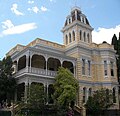


















![The Saitta House, Dyker Heights, Brooklyn, New York, built in 1899 is designed in the Queen Anne style[17]](https://upload.wikimedia.org/wikipedia/commons/thumb/4/42/Saitta_House_Dyker_Heights.JPG/90px-Saitta_House_Dyker_Heights.JPG)


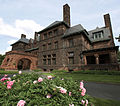



![Gingerbread trim on an 1882 house in Cape May, New Jersey[18][19]](https://upload.wikimedia.org/wikipedia/commons/thumb/7/72/Cape_may_pink_victorian.jpg/120px-Cape_may_pink_victorian.jpg)

























